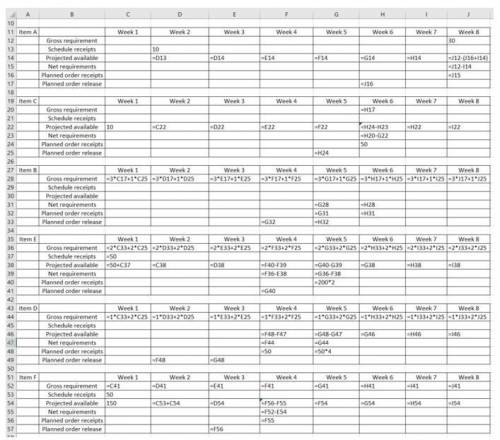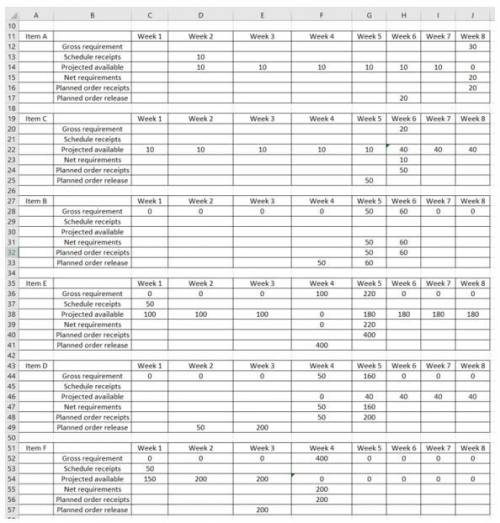
One unit of A is made of three units of B, one unit of C and two units of D. B is composed of two units of E and one unit of D. C is made of one unit of B and two units of E. E is made of one unit of F. Items B, C, E and F have one week lead times; A and D have lead times of two weeks. Assume that lot for lot (L4L) lot sizing is used for Items A, B, and F; lots of size 50, 50, and 200 are used for Items C, D, and E, respectively. Items C, E, and F have on hand (beginning) inventories of 10, 50, and 150, respectively; all other items have zero beginning inventory. We are scheduled to receive 10 units of A in week 2, 50 units of E in week 1, and also 50 units of F in week 1. There are no order scheduled receipts. If 30 units of A are required in week 8, use the low level coded bill of materials to find the necessary planned order releases for all components. Note: Simplify data handling to include the receipt of orders that have actually been placed in previous periods, the following six level scheme can be used. (A number of different techniques are used in practice, but the importance issue is to keep track of what is on hand, what is expected to arrive, what is needed, and what size orders should be placed.) One way to calculate the numbers is as follows:Gross requirementsScheduled receiptsProjected available balanceNet requirementsPlanned order receiptPlanned order release

Answers: 1
Another question on Business

Business, 22.06.2019 12:10
The following transactions occur for badger biking company during the month of june: a. provide services to customers on account for $32,000. b. receive cash of $24,000 from customers in (a) above. c. purchase bike equipment by signing a note with the bank for $17,000. d. pay utilities of $3,200 for the current month. analyze each transaction and indicate the amount of increases and decreases in the accounting equation. (decreases to account classifications should be entered as a negative.)
Answers: 1

Business, 22.06.2019 12:40
Acompany has $80,000 in outstanding accounts receivable and it uses the allowance method to account for uncollectible accounts. experience suggests that 6% of outstanding receivables are uncollectible. the current credit balance (before adjustments) in the allowance for doubtful accounts is $1,200. the journal entry to record the adjustment to the allowance account includes a debit to bad debts expense for $4,800. true or false
Answers: 3

Business, 23.06.2019 01:30
Which of the following is considered part of a country’s infrastructure?
Answers: 1

Business, 23.06.2019 06:00
What are some questions to ask a clerk in the dispatch office?
Answers: 1
You know the right answer?
One unit of A is made of three units of B, one unit of C and two units of D. B is composed of two un...
Questions

Mathematics, 13.04.2021 16:40






Mathematics, 13.04.2021 16:40

Mathematics, 13.04.2021 16:40

History, 13.04.2021 16:40





English, 13.04.2021 16:40

Mathematics, 13.04.2021 16:40

Mathematics, 13.04.2021 16:40

Spanish, 13.04.2021 16:40

History, 13.04.2021 16:40

Mathematics, 13.04.2021 16:40

Mathematics, 13.04.2021 16:40





